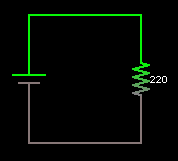Since I took my first Physics class during my junior year of high school, I have been taught Ohm's Law maybe three or four times now: once then, once in PHYS 2306 (Physics for Engineers II), ECE 2004 (Electric Circuit Analysis) and the lab for that class.
I am not saying that Ohm's Law isn't valuable - rather it's one of the only concepts in circuits that you can teach without using advanced math such as calculus and differential equations (which is most likely why most curricula don't proceed further until college).
However, it's not as effective to teach Ohm's Law without connecting it to Kirchoff's Voltage Laws (aka Loop Rule). KVL states that all of the rises and drops in voltage must equal zero. So if we have a circuit like the one below (the battery supplies 5 V).
We can see that all five volts are dissipated across the resistor, so the KVL is satisfied. In my opinion we should teach students that the current going through a resistor is ΔV/R rather than just V/R. That way it will include the voltage drop.
Now let's put this teaching into practice. For our first assignment in 2074 (circuits lab) we had to construct the following circuit (very easy)
Now that there are two resistors, all five volts aren't being dissipated across one resistor.
We weren't supposed to know what the last resistor was, and calculate it based on the voltage across that resistor and KVL, even though we could have just used a DMM or just figured it out through the colors.
Using a multimeter, I measured that the voltage drop across the resistor was around 3.24 V and that the current flowing through that resistor was 3.96 mA. We can rearrange the ΔV/R equation from earlier to get that R = ΔV/I.
R = ΔV/I
R = 3.24 V/ 3.96 mA
R = 818 Ω
The resistor was actually 813 Ω, which is within 5% tolerance and acceptable. The final wiring looked something like this.
So that's it for now - my next post will be on the board above, which we call the ANDY board.



No comments:
Post a Comment